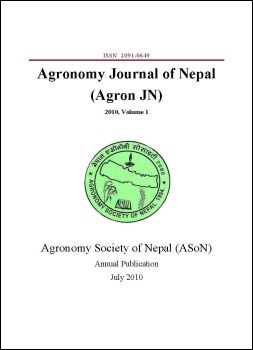Accumulated heat unit and phenology of diverse maize varieties as affected by planting dates under Rampur condition, Nepal
DOI:
https://doi.org/10.3126/ajn.v2i0.7526Keywords:
Diverse maize varieties, planting dates, phenology, GDD, heat use efficiencyAbstract
Accumulated heat unit and phenology of a full season open pollinated and three specialty corn (Zea mays L.) cultivars (Hybrid, QPM and Pop) were studied by growing them on three different planting dates (September 1, October 1 and November 1) in RCB design at Rampur Chitwan, Nepal during the winter season of 2009-10. The results indicated that the number of days required to attain different phenological stages were short for the early winter and gradually long for late winter plantings. For all the phenological studies, plants of normal sowing condition (September 1) recorded comparatively higher heat units than the late planting (October 1 and November 1) for all cultivars. Both early and late plantings recorded the higher helio-thermal units at advanced growth phases than at the early stages. The pheno-thermal indices at the earlier growth stages were significantly higher for early planting than the late plantings. The heat use efficiency (HUE) was found to be higher under normal planting as compared to the late plantings. Popular maize variety Rampur Composite was found to be the most suitable to produce stable HUE than the other varieties tested. The specialty corn cultivars could not show stable yield in late planting conditions suggesting their planting could be better for September sowing during early winter seasons.
DOI: http://dx.doi.org/10.3126/ajn.v2i0.7526
Agronomy Journal of Nepal (Agron JN) Vol. 2: 2011 pp.111-120
Downloads
Downloads
Published
How to Cite
Issue
Section
License
ASON permits for free use, distribution and reproduction in any medium if the original work is properly cited and not used for commercial purposes.




